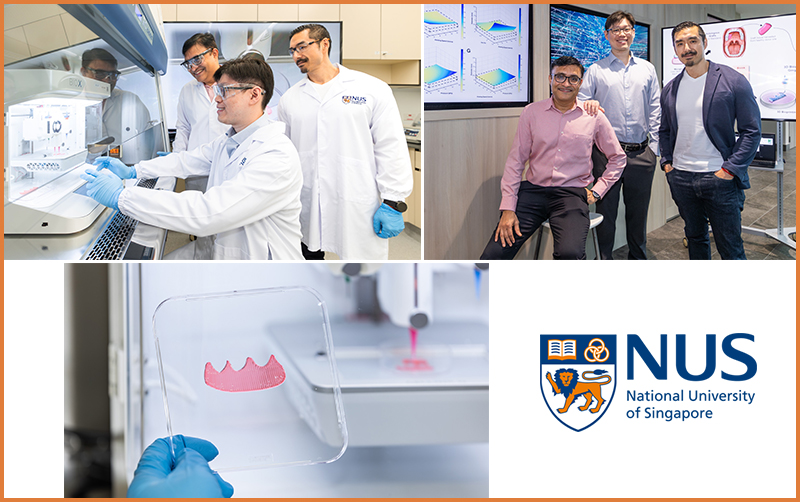
NUS researchers combine 3D bioprinting with AI to personalise oral soft tissue grafts
08 April 2025: A team of researchers from the National University of Singapore (NUS) has developed a method to fabricate personalised gingival (gum) tissue grafts using an innovative combination of 3D bioprinting and artificial intelligence (AI).
Led by Assistant Professor Gopu Sriram from NUS Faculty of Dentistry, the team’s approach presents a more customisable and less invasive alternative to traditional grafting methods, which often involve harvesting tissue from the patient’s mouth – a process that can be both uncomfortable and constrained by the availability of suitable tissue.
The 3D bioprinting and AI-enabled technique has the potential to address key challenges in dental procedures more effectively, such as repairing gum defects caused by periodontal disease or complications from dental implants. For instance, by enabling the precise fabrication of tissue constructs tailored to individual patients, the method can significantly improve treatment outcomes, reduce patient discomfort, and minimise the risk of complications, such as infections, during recovery.
Turbocharging the bioprinting process with AI
Gum tissue grafts are essential in dental care, particularly for addressing mucogingival defects such as gum recession, and complications arising from periodontal disease or dental implants. Typically, these grafts are harvested from the patient’s mouth. Though effective, these procedures come with significant drawbacks: patient discomfort, limited tissue availability, and a higher risk of postoperative complications.
To overcome these challenges, the researchers turned to 3D bioprinting, a technique that fabricates custom-made tissue grafts tailored to the specific dimensions of each patient’s defect. They developed a specialised bio-ink which supports the growth of healthy cells, while also ensuring the material can be printed accurately and holds its shape and structure.
However, the viability of 3D bioprinting is only as good as the parameters applied during the process. Factors such as extrusion pressure, print speed, nozzle dimensions, bio-ink viscosity and printhead temperature all play a crucial role in determining the final properties and performance of the printed component. Tuning these parameters has traditionally been done through tedious, manual trial-and-error experiments that are extremely time- and resource-consuming.
“To speed up the 3D bioprinting process, we integrated AI into our workflow to address this critical bottleneck,” said Professor Dean Ho, Head of the Department of Biomedical Engineering in the College of Design and Engineering at NUS, and co-corresponding author of the research paper. “This approach greatly streamlines the process by reducing the number of experiments needed to optimise the bioprinting parameters – from potentially thousands to just 25 combinations,” added Prof Ho, who is also Director of the Institute for Digital Medicine (WisDM) at NUS Yong Loo Lin School of Medicine, and N.1 Institute for Health (N.1) at NUS.
“Our study is among the first to specifically integrate 3D bioprinting and AI technologies for the biofabrication of customised oral soft tissue constructs,” said Asst Prof Sriram, who is also the Thrust Co-Lead of Dental and Craniofacial 3DP Applications at NUS Centre for Additive Manufacturing (AM.NUS). “3D bioprinting is by far more challenging than conventional 3D printing because it involves living cells, which introduce a host of complexities to the printing process.”
The future of dental care
In dentistry, the ability to produce personalised gum tissue grafts with improved efficiency, structural integrity, and biomimetic properties could address longstanding clinical challenges associated with periodontal diseases and dental implants. “This research demonstrates how AI and 3D bioprinting can converge to solve complex medical problems through precision medicine,” added Asst Prof Sriram. “By optimising tissue grafts for individual patients, we can reduce the invasiveness of dental procedures while ensuring better healing and recovery.”
Future research will focus on translating these findings from bench to bedside. The team plans to conduct in vivo studies to assess the integration and stability of the grafts in oral environments. They also aim to explore the integration of blood vessels into the grafts through multi-material bioprinting to create more complex and functional constructs. With these developments, the researchers hope to advance the field of regenerative dentistry while paving the way for broader applications in tissue engineering.
https://news.nus.edu.sg/combining-3d-bioprinting-with-ai-to-personalise-oral-soft-tissue-grafts
SOURCE National University of Singapore






